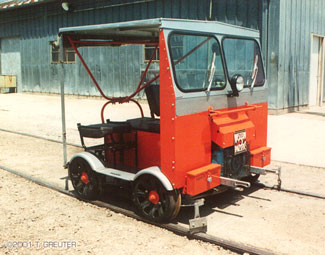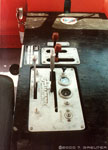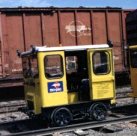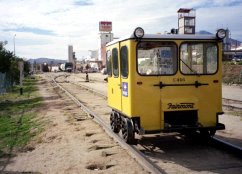|
||||||
| HOME Power Cabooses Rolling Stock MoW Depots | ||||||
Click on the thumbnails to see a larger image
|
Speeders Also known as track cars or motorcars, a speeder is motorized and does not have a hand pump mechanism. These cars were used by the railroad to transport workmen and supplies for maintenance. They were also used by MofW Dept. formen and supervisors to inspect the right of way. Today, they have been replaced by Hi-railers and pickup trucks fitted with retractable flanged rail wheels. Typically the car has a front windscreen, roof and rear bulkhead, the sides being open (they may have side curtains). They were often equipped for towing one or more trailers loaded with men and/or equipment. The Fairmont Gas Engine and Railway Motor Car Co. was the most popular manufacturer of these speeders, beginning in 1911. By 1949 Fairmont was offering 19 models of motorcars, most being available in 11 different gauges from 23" to 66". Today Fairmont is the only major speeder manufacturer still in business. After buying Tamper Inc. in 1991 it became Fairmont-Tamper, a world-wide supplier of a wide range of track maintenance equipment. There is an example of an open canopy Fairmont speeder (minus the engine, circa 1972) and push car in the book "Missouri Pacific Lines in Color" by Joe Collias on page 128. |
 |
C&EI 43 - at Warrensburg station. Note the Fairmont Speeder on the MoW truck; 1970's - Mike Cafferata Photo |
 |
MP Fairmont Speeder - skims idley by at Dallas, Texas. MoPac speeders came in a variety of paint schemes including yellow, orange and even some with diagonal safety stripes. August 27, 1983 - Brian Ehni Photo |
 |
MP-C165 - a Fairmont MT-19 Speeder. With the exception of the Western Pacific tin sign added to the front, this fine Fairmont-built example looks much as it did the day it was shipped new to MoPac on Feb. 8, 1978; Lincoln, Nebraska, 6/29/96 (this speeder has since been painted into WP livery) - Todd Greuter Photo |
| Some Stats on Missouri Pacific Speeder #C165 | |||||||
| Class - MT-19 | Series - 'A' | Group - 2 | Car # - 244531 | ||||
| Approx. Weight - 1000 lb | Approx. Top Speed - 40 mph | ||||||
| Shipped new - February 8, 1978 to the Missouri Pacific
Railroad Co. c/o D. J. Bertel, Ch. Engr. - Mtnce North Little Rock, Arkansas |
Scheme - Entire car painted Omaha Orange | ||||||
|
Original Equipment included: |
|||||||
|
|||||||
 |
MP-C165 - The Fairmont speeder weighs 1000 lbs and could reach a top speed of 40 mph. Privately owned by S. Jones, it's caught here parked on BNSF tracks at Lincoln Station, Nebraska. 6/29/96 - Todd Greuter Photo |
 |
Back view of MP-C165. - rear angle, Lincoln, Nebraska 6/29/96 - Todd Greuter Photo |
 |
MP-C165 - another rear angle, Lincoln, Nebraska 6/29/96 - Todd Greuter Photo |
 |
MP-C165 - At the controls of the MT-19; Lincoln, Nebraska 6/29/96. - Todd Greuter Photo |
 |
MP-C466 - a Fairmont MT-14m, seen at a motorcar event on the Camas Prairie Railroad (formerly UP), Lewiston, in north central Idaho in May 1999. Fittingly the speeder poses in front of another piece of MoPac equipment. - Wayne Parsons photo, as seen at Waynes excellent journal: Motorcars, Inspection Cars and Speeders. |
 |
MP-C466 - This speeder is completely enclosed with hinged doors. Its also now privately owned by W. Parsons, wearing MP emblems to proclaim its heritage. - Wayne Parsons photo, as seen at Wayne's excellent journal: Motorcars, Inspection Cars and Speeders. |
|
Some Basic
Fairmont Motor Car Types M-19 two-cycle engine generating about 8 horsepower with a belt drive. They may have a small water cooled radiator (steam condenser) prominently located up front. Inspection Car, two-seater with springs. Various models produced 1936-1981. MT-19 Most common Fairmont motorcar. Two-seater. "T" for "two-speed" and "19" is Fairmont's notation for a smaller car. Various models produced 1966-1986. * M-14 It is water cooled and has a belt drive. Four-seater Light Section Gang Car. Usually open with no sides and no springs. Various models produced 1922-1960. MT-14 Common larger car. The engine is an air-cooled, two-cylinder, horizontally opposed Onan of 18-22 horsepower. "T" for "two-speed" and "14" is Fairmont's notation for a larger car. Also has no springs. Various models produced 1967?-1986 * S-2 A large two-stroke, belt-drive motorcar. Standard Section Car, bigger than an M-14. Various models produced 1923-1982. A-6 A very large motorcar powered by a Ford 300 c.i. industrial engine. Heavy-Duty Section Gang Car capable of carrying a whole work crew. Various models produced 1939-1985. * Many Fairmont cars have two "T" model cites. This reflects Fairmont's
practice of offering a two-speed axle version of some of their belt-driven
cars, then a separate T model with a transmission, and usually an ONAN
engine. Both types of cars carry the same model number. |
|
Homebuilt Superintendant's
Inspection Car Some equipment is a bit harder to classify as these
old insection cars were just a tad fancier than your typical putt-putt. Traveling in Style This was probably built pre-WWII, with the Eagle colors added after 1940 when the heavyweight passenger cars were being repainted. By the 1950's it would be replaced by inspection automobiles with retractable flanged-wheels. The MPHS's 2004 Calendar offered online includes a formal MPRR photo of this car at the Grace Street roundhouse at Omaha, Nebraska.
Shades of the "Galloping Goose" An Otto Perry photo of this car can be seen online at the Denver Public Library.
|
|
Official colors doesn't always apply in every case. By it's very nature the equipment used in maintenance work were "hand-me-downs," surplus from mergers and out-dated/unfit for revenue-service cars. MoW equipment was a hodge-podge assortment. Overall, MoW colors were safety orange and some yellow, with yellow on newer equipment likely becoming less common by the late 1970's. The MoPac was a large system made up of many roads. Different areas on the system may have had their own preferred colors as well. According to Charlie Duckworth (who worked MPRR MoW in the 1970s) the specified colors of MoW equipment as of 1974 on the Northern Kansas Div., including the gang trucks and roadmaster pickups were MoPac's "Safety Orange" or "Omaha Orange." But the speeder schemes were a bright yellow with black wheels and black diagonal safety stripes, pushcars were also bright yellow. Some track alignment equipment may have been orange, but the speeders, at least in the early 70's, were always bright yellow. |
|
Pushcars/Trailers This equipment has been around as long as the railroad and been seen built in a variety of styles, they were easy for the railroad to homebuild to any specifications they required. Early models were all wood, with Fairmont turing out metal framed ones in more recent times. They were mainly put to task around the company car shops to move heavy parts. They are also well known for their use in MoW service, trailing behind a speeder to transport replacement crossties, spikes and other equipment. There is an example of both wood and all-metal push cars in use at the Sedalia Shops in the book "Cabooses of the Missouri Pacific Lines" by Jerry Michels on page 247. |
 |
Push Cars - these Fairmont-built metal-framed cars are at Union, Nebraska on 3/16/97. The MoPac preferred "Omaha Orange" paint on most of it's smaller MofW equipment in later years. There were exceptions, pushcars were seen in yellow paint or none at all. - Todd Greuter Photo |
| How Old is Too Old? The oldest equipment owned by any railroad often ended up in Mantainence work. Similarly, aging MoW equipment itself when it became old or more obsolete, would trickle down from the mainline to the smaller branchlines. Even as late as the 1960's, "Gandy dancers" a.k.a. pumpcars - which were entirely man-powered and among the earliest MofW vehicles used by railroads, dating back to the young days of Steam-power - could be seen running the rails of MoPac's Lincoln-Union Branch in Nebraska. |
| Specialized Trailers and Equipment Move over Rube Goldberg, nothing got more down-to-earth inventive then this class of machinery. |
 |
MoPac Speeder Derrick - built by Fairmont. Also known as a "Go-Devil", these little cranes were used on many railroads; seen at Dallas, Texas; 8/28/83 - Brian Paul Ehni photo, used with permission. |
 |
MoPac trailer #3154 - looking for all the world like a mystery machine, this is nothing more than a Weed Spray Trailer, seen on 1/1/65 at Algiers, LA. - photo: John C. La Rue, Jr. Collection, used with permission. Contact: mofwcaboose@aol.com for his list of r.r. photos for sale. |
|
Featured
Photography: |
|
Recommended Links: Motorcars, Inspection Cars and Speeders - Travels across the Pacific Northwest on a former MoPac Speeder KOSCIUSKO & SOUTHWESTERN RAILWAY Equipment Information - includes ex-MP speeder and shorty cab Houston.Railfan.Net - Main Page - photos of ex-MP 2-seater and Section Gang cars http://www.users.arn.net/~highball/temp/speeder.htm - 3 ex-MOP speeders, including Fairmont S-2 (MPC 5214) North American Railcar Operators Association NARCOA - Personal Motorcar Pages Google Search: fairmont speeder RailroadData.Com Railroad Links: Maintenance of Way: Motorcars and Speeders |
|
trainweb.org/screamingeagle l Last Update
to this page: 16 April, 2008
|
|
| All images & text © 2000-2008 T. Greuter / Screaming Eagles, unless otherwise noted. All Rights Reserved. | |